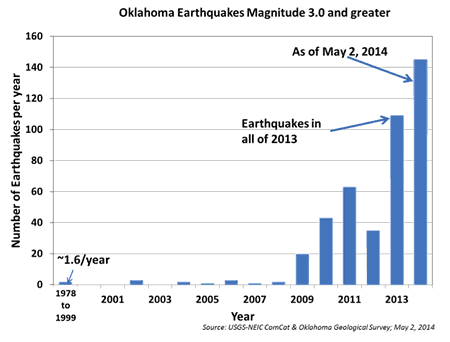

Central Oklahoma is at serious risk of a damaging earthquake, the U.S. Geological Survey and the Oklahoma Geological Survey said, pointing to the injection of wastewater into deep geologic formations as part of escalating oil and gas production as a major contributing factor to the heightened danger. Regardless of the cause, they’re urging the public to take steps to prepare for the potential damage that could result once a major event hits.
“We hope that this new advisory of increased hazard will become a crucial consideration in earthquake preparedness for residents, schools and businesses in the area,” Bill Leith, the USGS’s senior science advisor for earthquakes and geologic hazards, said in a statement. “Building owners and government officials should have a special concern for older, unreinforced brick structures, which are vulnerable to serious damage during sufficient shaking.”
 The USGS and OGS agencies point out that the state has dealt with 183 earthquakes of magnitude 3.0 or higher from October 2013 through April 14, 2014. That’s a huge jump over the long-term average. From 1978 to 2008, agency officials tracked an average two earthquakes each year of magnitude 3.0 or higher.
The USGS and OGS agencies point out that the state has dealt with 183 earthquakes of magnitude 3.0 or higher from October 2013 through April 14, 2014. That’s a huge jump over the long-term average. From 1978 to 2008, agency officials tracked an average two earthquakes each year of magnitude 3.0 or higher.
Both agencies say the rate of earthquake activity has increased so much that there is a chance that central Oklahoma could be hit with a magnitude 5.5 earthquake or greater. That’s based, in part, on the documentation of an historic magnitude 5.6 earthquake near Prague, Okla., on Nov. 25, 2011—the biggest since a magnitude 5.5 earthquake that damaged state buildings in Oklahoma City and hit near El Reno in 1952. The 2011 event hit after experts tracked 20 magnitude 4.0 to 4.8 quakes since 2009.
The USGS and OGS believe that injecting wastewater into deep geologic formations as part of oil and gas exploration and production has led to the higher earthquake risk, even as some have long-referred to Oklahoma as “earthquake country.” They said that injecting the wastewater can cause something known as “injection-induced seismicity,” where injecting water heightens pressure underground and lubricates faults. The end result: earthquakes.
Oil and gas producers dispose of the wastewater by injecting it into specially designed wells. Each agency said the earthquake spike is much more likely due to the industry practice rather than “random fluctuations in natural seismicity rates.” Meanwhile, their research into the central Oklahoma earthquake hazard risks and changes continues.